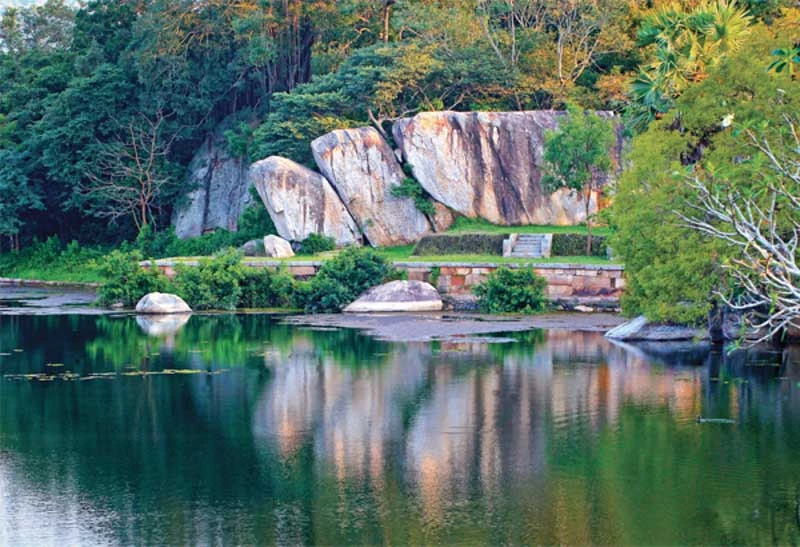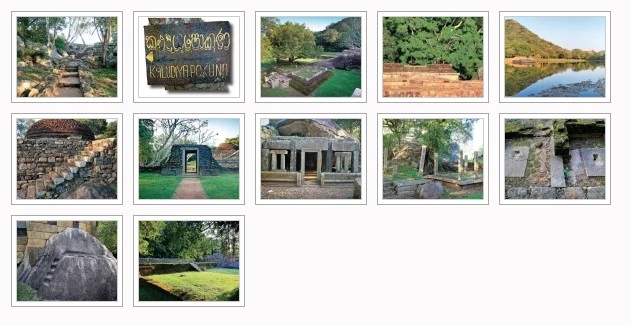
A glance towards the pond revealed the breathtaking view of a mountain mirrored in its dark surface. Looking above, mountains towered towards the sky encasing this waterbody in its midst. We were at the Kaludiya Pokuna in Mihintale pursuing the secrets hidden in its murky depths.
Words Krishani Peiris Photographs Indika De Silva
Ascending a staircase made of stone steps bordered by a light thicket, we alighted at the Kaludiya Pokuna or the Black Water Pond, which is 200 feet long and 70 feet wide. Ruins of an ancient monastery scattered around the pond greeted our curious eyes. Once called the Hadayunha Viharaya, the monastery is considered to be a donation from King Kashyapa.
Enriched with a fascinating history many tales are woven around the Kaludiya Pokuna. One ancient lore tells of a monk by the name of Kalubuddharakkhitha Thero who had sat with his back to a Kaluthimbiriya tree (East Indian Ebony) near the Kaludiya Pokuna on a new moon day and had preached the Kalakarama sutra to King Saddhatissa and his entourage. Some believe that the Kaludiya Pokuna became more renowned after this incident. Yet, it is assumed that the name Kaludiya came into being due to the blackness of the water that is caused by the reflections cast by surrounding rocks and trees.
Experts surmise that this pond was used as a place to observe ‘pohoya karma’ (cardinal tenets) and the building in the midst is a ‘pohoya gey’ (chapter house)
To our right we observed an olden dagaba that stood perched atop a landing. Made out of brick, only the dome has stood the test of time. Stepping through a stone archway that showed signs of having been part of an ancient rampart a little farther ahead, we strode along the length of a gravel path lined with grass, at points straying towards the pond where stone steps lead down to the dark waters. On the other side of the pond were ruins of a building made out of brick that rested in the midst of the pond. Certain experts surmise that this pond was used as a place to observe ‘pohoya karma’ (cardinal tenets) and the building in the midst is a ‘pohoya gey’ (chapter house). Begging to differ from this point of view, others point out that the space could have been utilised as an infirmary to care for afflicted monks.
More structures and remnants mimicking the pattern of edifices that had existed long ago encircled the grounds as the monastery is considered to depict a Panchavasa style where one raised structure is surrounded by others – such as an image house and a relic house to name a few. A curious rock with five holes caught our attention and we ventured to the place to observe it better. The four holes are thought to have been made so that either donations or monks bowls could be deposited there. A plaque nearby detailed an erased inscription that mentions of a person named Yuva who had donated a ‘ran kalandak’ (a small amount of gold). However, some experts believe that the inscription is mistakenly inscribed and should be understood as a ran kalasak (a pot of gold), which would constitute of a substantial amount worth mentioning.
The Kaludiya Pokuna is located near Mihintale. When coming from Anuradhapura and cruising along the Kandy-Jaffna Highway, take a left and the site will be situated on the right hand side.
Continuing on with our exploration, our steps next carried us towards a set of stairs that led to a distinctive structure where a square section surrounded by hollowed ground remained. It is thought that in ancient times the hollowed section, similar to that of a small moat, was filled with water and acted as a gateway to cool the building while increasing its charm. Also within this area were two well preserved toilet stones depicting the advanced sanitary facilities that were available in the past.
The golden light of the setting afternoon sun washed over the ruins and basked all with its warmth, betraying the glory of a past long gone
Surrounding all these structures and spread throughout a vast space were caves that were difficult to access. However, one cave located close by gave a glimpse of an abode that might have been accommodated by monks during the Anuradhapura era. The entrance and the windows were decorated with simple yet intriguing frames, made out of stone with faint carvings. Inside the floor cave was smooth and showcased the dedication put forth in maintaining a comfortable living space. It is considered that though originally only Mihintale was dedicated to monks with the ataseta len (68 caves) more areas such as Kaludiya Pokuna were employed to accommodate the increasing numbers during monks’ rainy season retreats. Further, the only Piyangala or Padahana Garaya (Study hall for monks) in Mihintale is assumed to have been established in the Kaludiya Pokuna Monastery Complex.
Tracing our steps towards a rock, where a flight of steps carved led to the top, we clambered up to catch the impressions of the monastery in the disappearing rays of the afternoon sun. The golden light of the setting afternoon sun washed over the ruins and basked all with its warmth, betraying the glory of a past long gone. The quietude that encased the periphery was only stirred by the call of a bird, the chattering of a monkey or by a gust of wind. Closing my eyes, I drifted to the days of yore where instead of ruins an impressive monastery existed filled with the vibrancy of life…



